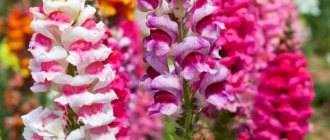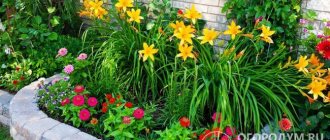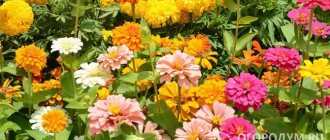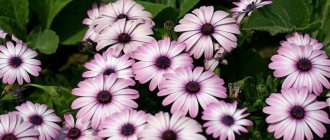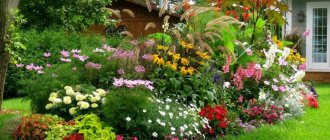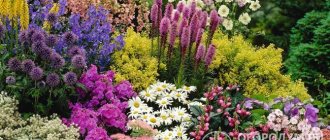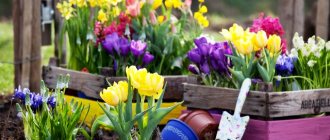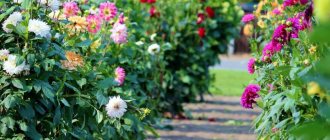Review author: Terrari School of Design
There's nothing better than a garden filled with gorgeous flowers. Their seductive scents and bold hues are the perfect way to highlight the beauty of the summer season.
But if the garden starts to look worse as temperatures get warmer or cooler, it's important to make a plan to keep the beds blooming from spring through fall.
This is a list of flowers that tolerate both heat and cold, shade and full sun. They can be planted and combined as desired, and these flowers are also well suited for use in landscape design.
With the help of a brief description of flowers, any gardener can easily collect the flowers they like for their country garden.
Sunflowers
- Annuals
- Colors: yellow, brown, yellow with red specks
- Height: 1.-3 meters
- Blooms in summer
- Most varieties are drought and heat resistant.
- Attracts bees, birds and butterflies
- Grows well in the sun
- Tolerates most soil types (except wetlands).
- May require support to prevent stems from breaking
In the shadow
On any local area there are shaded areas. Usually formed along fences or various buildings. You can't plant Victoria or other berries there. The lack of sunlight will affect the yield. But you can plant shade-loving types of flowers. The most common ones include:
- Primrose;
- Lungwort;
- Dicentra;
- Calceolaria;
- Mimulus.
Primrose is a low-growing flower crop. Grows well in the shade of tall and sun-loving crops. Grows up to 200 mm. The coloring is different. Flowering: April-May.
Primrose can be found in the forest, growing in the shade of trees
Lungwort is a spring-flowering bush. The period of bud blooming occurs in the second half of spring. The leaves are whole green or with light spots. The inflorescences change shade from pink to blue. Lungwort grows up to 400 mm.
Dicentra is small in stature, an excellent option for a rock garden. Flowering begins in May and ends in June. Color palette: shades of red, pink. The flowers look like a medallion, hanging from arched bases. Afraid of drafts. It is recommended to plant in the shade.
Dicentra inflorescences look like small hearts on a branch
Calceolaria is a colorful flower. Blooms in May-June. Rich yellow flowers. Grows up to 250 mm. Does not tolerate summer heat and sun. Requires moist, drained soil.
Mimulus has a rich, variegated color. Stems creeping or erect. Grows up to 70-150 cm. Racemose inflorescences in red or white colors. The soil should be moist.
Echinacea
- Perennials
- Colors: yellow, orange, white, purple, pink, two-tone and others.
- Height: up to 1.5 meters in height
- Blooms from summer to late autumn
- You can make beautiful bouquets from them
- Attracts pollinators and birds
- It is worth sowing seeds in spring or autumn.
- Loves rich, well-drained soil.
- Tolerates drought
It is best to plant in full sun. To experiment, try Lakota and Fire Coneflower to get a colorful combination of reds and purples in one plant.
Alyssum Clea Crystal Parple Shades
The name is not yet the most surprising thing about this unique tetraploid alyssum. Wow! So many unfamiliar words at once.
My first acquaintance with alyssum did not go well. I didn’t get the expected fragrant cloud over the flowerbed. And I didn’t notice any special beauty either. White alyssum reminded me a lot of weeds from the cruciferous family.
But this is what I would plant.
Alyssum
Clea Crystal Parple Shades is as unpretentious as regular alyssum and is fragrant. But the flowers are larger, the inflorescences are so lush that because of them the leaves are almost invisible.
You can sow directly into the ground in April-May. But the seeds are small - it’s better to put them in pots first so as not to lose the seedlings.
Zinnias
- Annuals
- Colors: shades of red, orange, yellow, pink and white.
- Height: up to 50 cm in height
- Blooms in summer
- Varies in flower shape depending on the variety
- Attracts butterflies
- Loves rich, well-drained soil.
- Has moderate water needs
- Grows best in full sun
Beautiful yellow porcupine calendula flowers
Calendula is one of my favorite flowers. I even love simple baskets. Not to mention these.
The diameter of the flower is 10 cm, the height of the bush is 60 cm. A very unpretentious flower, grown by sowing in the ground, blooms all summer. Self-seeds. It’s only in the second year that ordinary baskets can grow. But they still remain bright and medicinal.
Dianthus (clove)
- There are options for annuals and perennials
- Colors: shades of red, purple, pink and white.
- Height: most plants are from 20 to 50 cm, varieties up to a meter tall.
- Bright, fragrant flowers (with the scent of cloves)
- Blooms from May to August.
- Attractive evergreen green foliage
- Plant in well-drained soil
- Grow in full sun or light shade with more sun during the day
Flower garden design
Flower beds in the courtyard of a private house need to be arranged correctly. It's best to plan which plants you will plant in the shade. Preference should be given to unpretentious flowers that adapt to conditions in the shade. Lawn perennial grasses that reproduce in a flowerbed by self-sowing even in the shade are also welcome.
For perennial beautiful flower designs, it is better to choose low-growing plants in the yard. They are varied - these are pansies, salvias, and annual marigolds. The colors in the flowerbed in summer can also be varied. And such a beautiful decorative flower as pansy, combining several shades, will dilute a flowerbed in the shade with one variety.
Annual marigolds
As for various borders and flower pots, it is recommended to mix plants such as begonias and alyssiums in them. Such perennial flowers can grow not only in the shade on a plot near a private house, but the flowers also look good in a sunny place indoors.
Alyssiums
If you want to decorate a bright flower garden with plants in your dacha of different shades of foliage, plant beautiful cineraria, ageratum and coleus in places in the shade. Flowers with such names have very interesting foliage.
Cineraria
As a variety of separately planted flowers in a flowerbed in the courtyard of a private house, you can use beautiful lilies of the valley, violets, and low-growing roses. Lilies of the valley and violets, even in the shade of a flowerbed, will emit a pleasant aroma in the area when they bloom, if you water the flowers in time.
Low growing roses
Marigold
- Annuals
- A classic country flower that creates bright, beautiful spots in flower beds
- Colors: shades of yellow, red, gold, variegated - red with orange highlights.
- Height: from 15 cm to a meter in rare cases
- Blooms in spring, summer and autumn
- Grows quickly from seeds
- Repels mosquitoes
- Prefers well-drained soils and grows well in dry or sandy gardens.
- Requires good watering, but you need to let the soil dry out between waterings
- Should be grown in full sun
When and who to do flowers?
phloxes are widespread in landscape design.
Gardening has a very low barrier to entry .
Anyone can do it, and with proper hard work they can achieve certain heights. Children will be happy to help their parents in this matter, and then they will be able to take the initiative entirely, completely appropriating part of the garden for themselves. The best time to arrange a garden or simply care for flowers is when the main work on the garden is done, but the body requires more activity. Or vice versa, when there is no strength or just laziness to do something larger than taking care of plants.
Cosmea
- Annuals and perennials
- Colors: orange, pink, white
- Height: varieties 40 – 80 cm tall
- Blooms in spring, summer and autumn
- Grows quickly from seeds
- Repels mosquitoes
- Prefers well-drained soils and grows well in dry or sandy gardens.
- Requires good watering
- Should be grown in full sun with partial shade
Trees and conifers
It is not necessary to plant only bright flowers in your flower beds. Beautiful trees and shrubs that protect from dust look good near a private house in the shade and in the garden.
An interesting solution for a large plot of land in the shade would be to plant a pine tree. It is better to choose dwarf pines - they will grow even in the shade, but the roots of such trees will not damage the paths. Juniper is also popular - an evergreen plant that perfectly cleans the air. If you plant juniper under windows in the shade, it will protect the house from dust.
Decorative pine
Many gardeners recommend planting birch and viburnum in the shade near a private house. These trees have good energy, they grow large, especially the roots of the birch and the branches of the viburnum.
Birch
As a shrub that can also bloom, many people prefer to plant lilac near the house. Although lilac blooms only in spring, it blooms magnificently and for a long time. At the same time, in summer the plant will delight you with dark green leaves in front of the house. And caring for unpretentious lilacs in the shade is not difficult.
Lilac
Rose hips will exude a pleasant aroma, and you can use its fruits to make tea.
Rose hip
Many people decorate the flower beds in front of the house with roses, which first grow into bushes and then produce branches that can be clinging to something. The combination of blooming decorative rose buds with juniper trees in the flower beds in the courtyard of a private house looks unusual.
Roses
If you decide to plant a variety of plants in the flowerbed in front of the house, as well as shrubs in the shade, then it is advisable that the decorative background in the landscape design be unpretentious grass, which is easy to plant or sow. Sprinkle the soil in the flowerbed with compost in advance and water it. Such grass, even in the shade, will not only give a decorative look to a flower bed with a variety of flowers, but will also improve the soil and make it easier to care for shrubs.
Several ornamental grasses
To ensure that the plants in your yard grow without creating problems with care, think over the design and also decide on the varieties. You need to take into account the care requirements for certain flower names before planting anything near your home.
Convolvulus
- perennial
- Colors: white, purple, pink, red, blue, there are varieties of variegated colors
- Height: spreads from one meter to 2 meters
- Blooms in late summer or early autumn
- Bindweed is a flower that sows itself; you need to be careful not to fill the entire summer cottage with it
- Attracts birds and butterflies
- The seeds are very toxic if ingested
- Prefers moderately fertile, well-drained soils. The plant needs to be watered weekly during dry periods.
- Plant in full sun
List of unpretentious annual flowers that can be sown as seedlings
Many beautiful annual flowers are completely unassuming. Growing them in your garden and caring for them is very simple!
Marigold
Marigolds (or Marigolds, Chernobrivtsy, Tagetes) are one of the most cheerful flower crops in the garden. In addition to open ground, marigolds can be grown on a western or eastern balcony. The bright yellow and orange color evokes pleasant associations with the sun. Flowering usually begins in early summer and lasts until frost. Annual marigolds are very easy to grow; they are unpretentious and undemanding. If you choose the right place to grow tagetes in open ground, you can completely forget about the plant, except for watering. The place should be sunny, with loose, water- and breathable, neutral, moderately fertile soil. In addition to their unpretentiousness, I would like to note the phytoncidal and insecticidal properties of marigolds, thanks to which they repel pests and prevent the proliferation of pathogens.
It is better to sow marigold seedlings in early April, because the seedlings grow quite quickly. Seeds are sown in individual cups or plastic cassettes to a depth of 1 centimeter and covered with soil. Planting in a common box is also not prohibited; you need to make rows 1 cm deep at a distance of 2-3 cm, the seeds are distributed in a furrow with an interval of 2 cm, and covered with earth on top.
Calendula
Calendula (or Marigold) is very easy to grow in the garden. Bright and perky flowers can delight from June until frost. It also has useful insecticidal and phytoncidal properties that protect it and neighboring plants from pests and fungi. The picky annual crop prefers sunny areas with fertile soil (although in general it is unpretentious to soil!).
You can plant calendula seedlings in the second half of March, in the first half of April. It is recommended to sow immediately into individual cups or cassettes. Calendula seeds are placed in a hole 2 cm deep and covered with earth on top. By the way, it is recommended to prepare the planting material by soaking them in a solution of a growth stimulator before sowing.
Cosmea
Cosmea (or Cosmos) is characterized by its delicate, sweet, weightless beauty, and at the same time it is one of the most unpretentious annuals. It blooms all summer until late autumn. Even an inexperienced novice gardener can cope with the task of growing cosmos in open ground. Letnik reproduces well by self-sowing. It is not picky in growing conditions, but for maximum flowering beauty, planting in a sunny, open area with light, nutritious, loose soil is recommended.
Planting cosmos seedlings is very simple: fill the cups with soil mixture, place 1-2 seeds on the surface of one container and lightly press them into the substrate. You should not cover it with soil.
Eschszolzia
Eschscholzia (or California poppy) is a very hardy and unpretentious plant, and this is not surprising, because the flower’s homeland is the semi-deserts of North America. Therefore, you can safely grow drought-resistant and undemanding watering Eschscholzia without special care. Bright yellow and orange flowers bloom from early summer to mid-autumn. If you do not remove faded inflorescences, then propagation by self-sowing is possible.
It is optimal to sow Eschscholzia for seedlings in early March. Seeds are sown immediately in separate cups, peat tablets or plastic cassettes; there should be one or two seeds in one container; they are covered with a 1 mm layer of sand or soil on top. After planting, it is necessary to place the containers in the refrigerator for 2-3 days, and then move them to warm conditions.
Zinnia
Zinnia can be a real treasure for any gardener. With minimal care, it can delight with its spectacular beauty and long flowering (from early summer until the first frost). It is resistant to pests, diseases, and drought conditions. However, she needs a sunny, warm, wind-protected place with a nutritious, neutral substrate.
It is optimal to plant zinnia seedlings at home in early April. To grow seedlings, you should initially choose individual cups, cassettes, and peat tablets. Seeds are sown in holes 3-5 mm deep and covered with soil on top.
Purslane
Decorative purslane has beautiful flowers and fleshy oblong leaves. The flower is completely unpretentious in care, quickly grows over the surface of the soil, forming something like a carpet (that’s why the flower is often called a “rug”). Blooms throughout the summer. Purslane is resistant to hot and dry conditions, pests and diseases. Of the care features, it is only worth noting regular watering in hot weather, but it should be moderate to avoid excess moisture. It is recommended to plant in open ground in the most illuminated, open place; the picky crop feels best on sandy, dry, poor soils.
Purslane is sown for seedlings at the end of March, at the beginning of April. The container should be wide and shallow, and the soil mixture should contain a large amount of sand. It is necessary to sow superficially; it is convenient to mix them with sand and sow.
Alyssum
Alyssum (or Lobularia marine) is extremely easy to grow and undemanding to care for. The flower ground cover crop has not only graceful, delicate flowering, but also an attractive honey aroma. Therefore, this crop can be grown to decorate and flavor the garden. Able to reproduce independently in open ground by self-seeding. The conditions required are standard for many plants: a sunny, ventilated place, well-drained, loose soil.
It is optimal to sow alyssum for seedlings at the end of February, in the first and second ten days of March. You can simply sow the seeds superficially over the surface (and then be sure to thin them out), and cover the top with a thin layer of sand (literally 2 mm). Or you can make grooves 3-5 mm deep with a gap of 4 cm from each other, scatter the seeds into the grooves at a distance of 1.5 cm and cover them with sand or soil on top.
Matthiola bicornuum
Matthiola bicornuum is planted for its pleasant sweet aroma, which intensively reveals itself in the evening and at night. Annuals are not particularly decorative, so they are used to create a fragrant garden. Blooms from June to early September.
Matthiola bicornuum is planted for seedlings in the second half of March. Seeds should be stratified on a damp cloth in the refrigerator several days in advance. Plant in a wide, low bowl, using not very fertile soil. The seeds are evenly distributed over the soil and covered with a 3 mm layer of sand on top.
Aster annual (Callistephus)
Annual Astra (or Callistephus) is a cold-resistant, drought-resistant plant. Only needs watering in dry weather. The annual aster blooms in August until frost. The culture delights not only with its unpretentiousness, but also with its variety of shades (flowers can be white, blue, red, pink, purple, lilac, etc.). It should be planted in well-lit areas of the garden. Moreover, for the most beautiful flowering, it should grow in a place protected from the wind, which is protected from too bright sun at midday. Callistephus is undemanding when it comes to soil, but it will be more comfortable on loose, moderately fertile, light, permeable soil.
It is optimal to sow annual aster for seedlings at the end of March. Planting is done in a common low bowl, the distance between the seeds is about 2-3 cm, they are covered with soil 5 mm thick.
Nasturtium
Elegant nasturtium is suitable for vertical gardening, for growing on the balcony. When growing nasturtium through seedlings, flowering occurs from June until the first frost. A flower can easily grow and bloom in the country without careful care, but it is important to satisfy its needs: the plant needs a warm, sunny place, with moderately fertile, loose, moderately moist soil. In terms of caring for nasturtium, it will require regular watering and timely tying to the support.
Nasturtium seedlings are planted at home in April in individual cups; a hole 2 cm deep should be made in the center of the container, the seed should be placed there and covered with soil.
Nasturtium
- annual
- Colors: shades of orange, red, yellow, cream
- Height: 1-1.5 meters
- Fast growing and colorful
- Blooms from May to September.
- Edible leaves and flowers (recipe: Sautéed Halibut with Nasturtium Butter)
- Needs well-drained soil
- It is worth watering regularly, but without overflowing
- Plant in full sun
Viola Sugar Flower
Producers began to present us with the excellent gastronomic qualities of flowers. Does everyone already know that you can eat marigolds, yellow sunflower tongues and nasturtiums?
Do you know about viola? And the names are given by edible ones - Sugar flower.
Candied viola flowers are the height of culinary fashion. But simple flowers often serve as decoration mainly for sweet products (jelly, yogurt, cakes) and are added to salads. Viola tastes sweet.
To flower this year, you need to sow seedlings in March-April. When sown outdoors in June-July, it will bloom in the second year.
Pansies
- Grown as annuals (can be perennial/biennial in zones 6-10).
- Colors: a variety of colors from white to dark purple
- Height: about 20cm high
- In warmer climates, pansies will bloom throughout the winter and early spring.
- Attracts butterflies
- Loves rich, well-drained soil.
- Needs regular watering
- Blooms in sun or partial shade
- Grows best at a temperature of 15-24 degrees
Beautiful flowers of perennial lobelia
I have never seen such lobelia before. Usually grown as an annual, compact, with small flowers, often ampelous. And here there is such beauty - in the bush.
This is a perennial lobelia , frost-resistant, American selection. The height of the bush is up to 80 cm. If grown through seedlings, it will bloom in the first year.
If I find seeds, I will definitely plant them.
Snapdragon
- Grown as annuals (can be perennial in zones 5-10)
- Colors: white, yellow, pink, red, orange, peach, purple and dark purple.
- Height: 20-25 cm in height
- Blooms from spring to fall in cool summer growing conditions.
- Attracts butterflies
- Prefers well-drained soil
- The base of the plant needs to be watered regularly
- Blooms best in full sun
Daisies
They look charming and cute on the site, so they have become a favorite among most gardeners.
- Flowers can be not only ordinary: there are double and semi-double varieties.
- They are not picky about soil composition, but they grow best on light loam. They prefer well-lit areas and do not like stagnant water at the roots.
- One of the early varieties. It blooms as soon as the sun warms up - in late April or early May.
- The culture is resistant to diseases and pests.
Pink, red, and white colors are especially popular.
Geranium (Pelargonium)
- Grown as annuals
- Colors: white, pink, red, lavender, violet, purple and crimson
- Height:7-50cm in height
- A flower that does not require care from spring to frost
- Suitable for growing in window pots, hanging baskets, containers or just in the garden bed.
- Attracts birds and butterflies
- Grows in rich, well-drained soil.
- You need to water regularly, but do not overwater.
- Prefers full sun/midday shade in hot climates
For a beautiful and well-kept flower garden and longer stems and lush flowers:
- Plant flowers close to each other in your summer cottage. This will reduce the number of weeds and increase the number of flowers in the garden.
- If flowers are grown for cutting, do not forget to grow foliage and “filler” plants for compositions
- To allow flowers to grow and reproduce naturally, but within reach of the lawnmower blades, it is worth installing rectangular slabs around the beds.
- Make the paths between the flower beds wide so that the flowers do not get under your feet when walking through the garden.
- choose smaller varieties to reduce pruning time, and plant shrubs in the center of the flower bed to provide year-round structure and height.
- Water your flowers regularly
- Collect seeds from annuals and perennials for next year
The benefits of working with flowers
hydrangea. Sage and Echinops “get along” well with each other.
Working with flowers in the country has obvious practical benefits for humans, which consists of several factors.
- Meditative character. Planting, caring for, or simply watching flowering plants relaxes a person, allowing him to forget about pressing problems for a while and just enjoy. Good for the nervous system.
- The physical load when working with flowers is quite low, but it is still there. At the same time, a long stay in an open country space with less pollution than in the city. The combination of these factors improves the overall health of a person.
- Unity with nature. The pleasant smell of flowers will not leave anyone indifferent.
In addition, thanks to working with flowers, the area is gradually improved . With each flower planted, the dacha will be transformed for the better. And the more effort you put into gardening, the more noticeable the result becomes.
With the proper approach and understanding of the basic principles of planting and growing for a summer resident, the flowers on the site will become a delight, a place for the manifestation of one’s own imagination and taste.
Photos of flowers for the garden
Perennial flowering plants
Perennials are very convenient to grow in flower beds - you do not need to worry about seeds, seedlings and preparing the soil for planting every year. Many of them are unpretentious and bloom all summer. Such plants include:
- cornflowers;
- lobelia;
- perennial flax;
- aquilegia;
- garden tradescantia;
- yarrow;
- arabis;
- astilbe;
- delphinium and many others.
Roses require more care: they need to be regularly pruned, loosened and fed. They must be covered for the winter. Roses pay for their care with magnificent blooms that last all summer. At the end of the summer season, when many plants have finished blooming, autumn chrysanthemums bloom. They bloom until frost and fit perfectly into the garden composition.
Against the background of greenery, garden daisies look great and can decorate any yard. They are unpretentious: they tolerate drought well and do not require close attention. There are different varieties of daisies: large cornflower, red and pink pyrethrum, yellow doronicum. There are even terry varieties, similar to asters and chrysanthemums. Daisies combine well with other perennials and small shrubs.
A good addition to other plants that grow in the yard is gypsophila. This is an unpretentious flower, perennial varieties of which grow in one place for 25-30 years. Gypsophila is easy to care for - just water and feed occasionally.
Pelargonium is usually grown as a houseplant, but in the summer it can be transplanted into an outdoor flower bed. It develops well on the sunny side and produces many inflorescences in open ground. In order to grow pelargonium next year, you need to cut several cuttings and plant them at home.
Perennials and their advantages for the garden
- there is no need to make a selection of new colors with the arrival of each new season
- the formed flower garden will only grow and delight with new inflorescences
- These flowers have a stronger root system
- minimal maintenance, which is very convenient for those who cannot be at the dacha all day long
- such plants are more resistant to frost
- no extra expenses for seeds before the start of the season
In order to choose specific positions, you should first find out the composition of the soil in which they will need to be planted. As a rule, caring for perennials is simple and involves regular watering, as well as fertilizing from time to time.
Annuals
The short lifespan is the only drawback of these crops, but they are not prepared for wintering, and there is a chance to experiment with their plantings, changing the design of the property.
They reproduce by seeds or seedlings and bloom for a long time. It will take 1-2 months for the seedlings to color the flower beds with incredible shades. The best annual flowers for the garden:
- marigolds that repel garden pests;
- pink viola;
- salvia;
- zinnia;
- ageratum;
- lobelia;
- nasturtium.
Wildly blooming multifaceted petunias are a classic of the genre that never goes out of fashion.
Arrangement of flower beds
Whatever they use when equipping flower beds, they use old tires, hemp, and scrap materials. Designs can be of different geometric configurations and multi-level types.
Mixborder includes different vegetation both in height and in terms of flowering time. Rabatkas frame paths or the perimeter of a building, curbs are low and narrow stripes. Rocky alpine hills are popular among summer residents.
When planting, they follow the principle of placing tall crops in the center with a decrease in growth towards the bottom. Combine perennials and annuals harmoniously in color or use the method of complete contrast. You can liven up the landscape with cereals.
Climbing species
The two-meter hollyhock or mallow is the queen of the garden; it is used as a hedge or as the central element of a plant ensemble. She does not like transplants because of the long rhizomes, which are easily damaged. A durable arched structure made of metal and wood serves as a support for ivy, virgin grapes, morning glory, peas, decorative beans, and clematis. In this extraordinary way you can decorate the entrance to the gazebo.
General principles for placing flowers in the front garden
Having thought about how to beautifully plant flowers in the front garden, they usually select them in such a way that flowering periods constantly replace each other throughout the summer season. The background for flowering plants can be made from shrubs or evergreen conifers.
On the territory of the front garden you can place not only plants, but also equip a recreation area
To make the composition look harmonious, choose the main object around which the rest of the plantings are planted. Such a focal point can be a small tree, a shrub, a group of tall plants of the same species, or a decorative arch that serves as a support for climbing flowers.
An arch in the front garden can become the main decorative detail of the composition
Large specimens of plants are planted in the background of the composition, and more compact species are added next to them. Bright and expressive plantings are placed near the porch or gate, as well as in places with an abundance of sunlight, which will highlight their advantages.
The brightest accents in the front garden can be made with the help of plants planted near the gate or porch
To correctly combine plants in a flower garden with each other, it is recommended to adhere to the following rules:
- take into account the timing of flowering of plants and plant nearby those specimens that can replace each other as their growing season completes;
- tall trees and spreading bushes should not shade the house or interfere with free movement around the front garden;
- observe restraint and unity in the selection of plant colors - too many shades will create chaos in the flowerbed;
- the appearance of the front garden should be combined with the rest of the plantings and the style of buildings on the site;
- When choosing plants for a flower garden, take into account the location of the cardinal directions and the plants’ requirements for comfortable growth conditions.
To ensure that the plantings look well-groomed all year round, they are selected in accordance with the climatic characteristics of the area. For example, in areas with harsh winters, southern firs or cypresses will have to be protected from frost, and the front garden will look unattractive.
Attention to the microclimate near the wall
The first and most important thing to consider when selecting plants for planting along the walls of a house is the microclimate that prevails there. And the microclimate, in turn, depends on the side of the world that the wall faces. Below we list several nuances that will help you correctly plan a flower garden along the wall of the house.
- North wall. If the area where you plan to plant a flower garden comes into contact with a wall that faces north, things are bad. In the sense that you will have to work a little in order to organize a beautiful flower bed. But know this: nothing is impossible. The main difficulty is that under the northern wall there is usually pitch darkness. And due to the fact that the sun practically does not reach here, the soil in this area is usually very waterlogged. However, such a microclimate is a real blessing for evergreen plants. They love moisture. And protection from the bright sun in the spring and winter is a vital necessity for these representatives of the flora. Another contender for this site are shade-tolerant perennials. In early spring, the snow does not melt off the northern wall of the house for a long time. In such conditions, rhizomatous perennial plants are very comfortable. In addition, such a microclimate allows them to calmly overwinter and feel protected from frost all winter.
- South wall. On the south side of the house everything is much simpler than on the north. Almost any plant can be planted here. Except perhaps those listed in the previous paragraph that do not like sunlight and dry soil. However, in the case of the flower bed along the southern wall, there is one catch. If there is not too much space between the wall and the fence, and the fence is solid and practically not ventilated (that is, not made of chain-link, for example, but made of corrugated board), the flowers that are planted in this location can be very hot in the summer. They may suffer from excessive ultraviolet radiation and high temperatures. Therefore, this point must be taken into account when laying out a flowerbed.
- Western wall. The flower garden, organized along the western wall of the house, is a real paradise for heat-loving ornamental crops that love to bask in the warmth of the sun, but do not like direct sunlight. The advantage of the western wall is that it accumulates the heat of the sun no worse than the southern one. However, at this location there is no aggressive ultraviolet radiation or direct rays that can burn succulent leaves. In general, any plants can be planted along the western wall. Except for those crops that need sunlight throughout the day.
- Eastern wall. The eastern side of the house is considered the most treacherous. The main difficulty is that during the day the temperature in this area can “jump” greatly, changing either higher or lower. And this, as you understand, will not appeal to every decorative crop. When the sun rises, the soil on the east side of the house warms up faster than other areas. But in the evening it cools down the fastest, since in the afternoon the sun no longer hits it. Therefore, when selecting plants for a flower bed along the eastern wall, it is important to take this nuance into account. And by the way, if you live in the southern region, then the eastern wall can be an excellent outpost for plants that need protection from morning frosts.
A multi-component mixborder is unlikely to look good in such conditions. Unlike a ribbon flower garden, which includes three or four crops, and which, in turn, will alternate with each other. It is worth using ground cover plants as a plant barrier in such a flower garden, and the soil can be safely mulched with decorative materials. It will turn out discreet, minimalistic, but very beautiful.
Due to the fact that the flower bed along the house is usually narrow, you should not rely on a wide palette of colors. Two colors will be enough to make this flower garden spectacular and attractive. If the area along the wall is not just narrow, but very narrow, it makes sense not to scatter among different decorative crops, but to choose just one - the most suitable one. A monoflower in such a situation is exactly what is needed.
